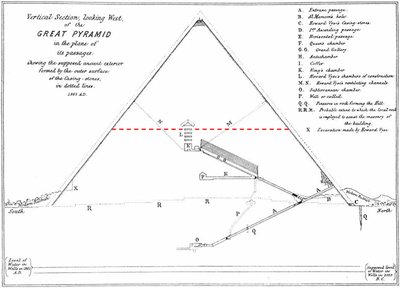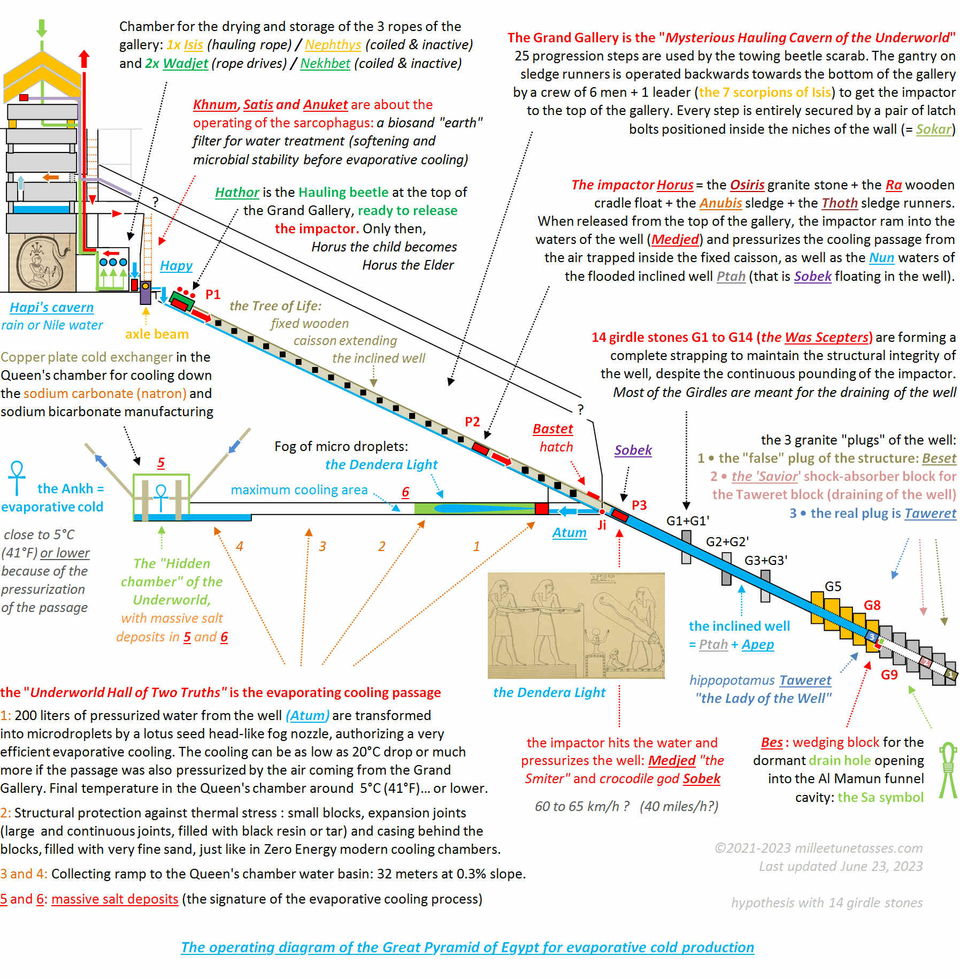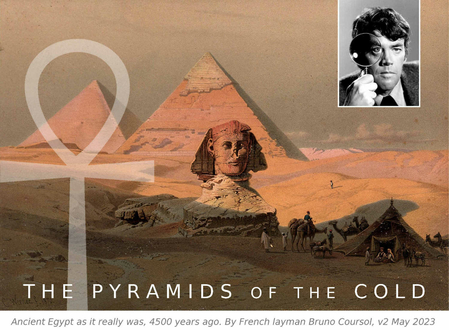- Retour accueil
- Vous êtes ici : Blog The Pyramids of the Cold v2 The Pyramids of the Cold Section 31 • The Pyramid's Flat roof and the water supply issue
The Pyramids of the Cold Section 31 • The Pyramid's Flat roof and the water supply issue
Publié par Bruno Coursol dans The Pyramids of the Cold v2 le 13/05/2023 à 18:49

Ancient Egyptian god of the Nile Hapi, in his "cavern", creating the very first snake with his own water.
Dhows on the Nile, by Jerzy Strzelecki: https://en.wikipedia.org/wiki/Nile#/media/File:Nile03(js).jpg
The Pyramids of the Cold v2 (May 2023) • Part F: the King's chamber of the Great Pyramid
Section 31 • The operating flat roof of the Great Pyramid and the water supply issue

Summary: the origin of the water used to power up the Great Pyramid is probably the first question that would need to be answered, as it really can change the whole "atmosphere" of the Pyramid's operation, so to speak.
• the water could have been coming from the Nile river (hence the importance of the Nile god Hapi),
• it could have been rainwater (because of the flat roof of the unfinished operated Pyramid),
• and it could have been a combination of both, probably depending on the season the Pyramid was intended to be operated, and the technical requirements of the biosand sarcophagus in terms of minimum and maximum turbidity acceptance of the supplying water.
I've personally supported both first hypothesis, and maybe the third is the correct one.
Anyway, the best to do is probably to present the problem and the clues I could find and let you make up your own mind.

A perfect modern water metaphor, thanks to Aaron, in "My 2015 Four-Metaphor Poem about Writer's Notebooks": https://corbettharrison.com/documents/lesson-docs/Metaphors/Poem-2015.pdf
A felucca traversing the Nile near Aswan, by Jordan Busson: https://en.wikipedia.org/wiki/Nile#/media/File:Dhows_on_the_Nile.jpg
31.01 The risk that god of the Nile Hapi is just another metaphor
The first thing that comes to mind about the water supply of the Great Pyramid, is of course water from the Nile; of course, because of god of the Nile Hapi who is so important in the deciphering we've already accomplished.
But, and this is a huge "but", we've also seen in so many occasions that pretty much everything presented to us by ancient Egyptians, was only metaphoric. So there is a very serious risk that god of the Nile Hapi himself is only another one of these countless metaphors.
Can god of the Nile Hapi be taken literally, or is he only another metaphor… that is the question!

Because the Great Pyramid wasn't finished at the time of its operation and the presence of a temporary more or less flat roof, the Gantenbrink's Doors were real hatches opening to the exterior of the pyramid. Gantenbrink's Doors were real "doors".
31.02 The Gantenbrink's Doors were hatches opening on the flat roof of the operating Great Pyramid
It has to be pointed out that at the time of the operation of the Great Pyramid for evaporative cold production, like I've said many times, the pyramid wasn't finished and there was what could be assimilated to a flat roof.
That flat roof explains that Hapi is described as being "under the Sun".
Many elements are pointing to the flat roof design of the Great Pyramid, when it was in operation. The elevation level of that flat roof was probably set by the Gantenbrink's Doors that would have been more like hatches that real "doors", and would coincide with the elevation level of the Lady Arbuthnot's chamber, where the granite walls of the "relieving" chambers are suddenly replaced by usual limestone blocks.
1 • The mysterious Gantenbrink's Doors closing the upper part of the Queen's chamber shafts
2 • The northern King's chamber shaft change of direction
3 • The walls of the Lady Arbuthnot's chamber which are made of limestone, while all the other walls of the "relieving chambers" are made of granite, just like all the beams of the floors and ceilings of these chambers.

Structure of an ancient Egyptian mastaba, by former CNRS French architect and archeologist Jean-Claude Golvin (Bordeaux): https://jeanclaudegolvin.com/project/egypte/egypte-gizeh-pyramides-mastaba-jc-golvin/
31.03 The operating Great Pyramid of Giza would have just looked like a mastaba... because it probably really was one
It is amusing to note that in all the structure images of the mastabas one can find, there is almost every time the same two openings, which really look like the draw I've made of the two Gantenbrink's doors that would open to the flat mastaba roof of the operating Great Pyramid.

Bent Pyramid internal layout by Franck Monnier: https://fr.m.wikipedia.org/wiki/Fichier:Bent_Pyramid_substructure_2.png
31.04 The flat roof design probably already used in Sneferu's Bent Pyramid
Actually the Great Pyramid would have looked like something close to the first half of the Bent Pyramid; and of course, the fact that this pyramid is "bent" in the first place, is most probably explained by the same necessity of using that "flat roof".
31.05 Hapi lives in the distant south and under the Sun
That flat roof also explains why Hapi was described as "living under the Sun": there probably was some kind of access to the Grand Gallery through something that might have resemble to a "central chimney" that would have allowed fresh air as well as the crewmembers of the Hauling beetle to get into the Gallery.
"Hapi lives in the distant south, in a cave never seen by anyone under the sun and pours the water of the Nile from her/his carafes." http://egyiptom.freeweb.hu/english/gods_hapi.html

Elevation diagram of the interior structures of the Great Pyramid. 10 shows the King's Chamber and its "star shafts". 7 shows the Queen's Chamber and its shafts: https://en.wikipedia.org/wiki/Star_shaft#/media/File:Great_Pyramid_S-N_Diagram.svg
31.06 The elevation diagram of the interior structures of the Great Pyramid
About the discovery of the Gantenbrink's doors: "This find in the northern shaft, coupled with last week's discovery ... in the southern shaft, represents the first major new information about the Great Pyramid in more than a century." - Zahi Hawass to https://www.cheops.org/
Images of the Gantenbrink's doors at: https://www.pyramidofman.com/shafts/

The strange trajectory of the northern King's chamber shaft of the Great Pyramid of Giza.
Original images thanks to the Bibliothèque nationale de France. "Histoire de l'art égyptien d'après les monuments, depuis les temps les plus reculés jusqu'à la domination romaine" 1858-1879, by Émile Prisse d'Avennes (1807-1879). © Bibliothèque nationale de France, département Réserve des livres rares: http://passerelles.bnf.fr/grand/pas_2457.htm
31.07 Hapi's cave and its two spring holes are about the King's chamber and its two shaft openings
One of the most interesting parts of the mythology about Hapi is how were created the waters of the Nile: ancient Egyptians believed that inside their paradise, the "field of the blessed" in the underworld, was running a river which came from the heaven "in a mysterious way" and was filling Hapi's cave passing through two spring holes.
Like everything else, it is a very cute story which only originates in the Great Pyramid and in particular in the King's chamber itself. Because these two "subterranean channels" and two "spring holes" are simply about the northern and southern shafts of the chamber.
"...the Egyptians held of the origin of the Nile and the connection of its sources with the Egyptian paradise in the netherworld. According to these "the fields of the blessed" which is the Egyptian paradise, were encircled by "a river" (itru) that went forth from heaven. In a mysterious way that river reached the surface of the earth, through two spring holes below the first cataract between Elephantine and Philae and emerged as the Nile. This idea is pictorially represented in a relief in a small island near Philae, at the first cataract. Under a mass of rocks, the god of the Nile, Haapi, protected by a serpent, is pouring out of two vases in his hands, symbolising the two sources of the Nile. Thus the Nile was merely the earthly prolongation of the heavenly "river" (itru) and the two spring-holes beneath the cataract only marked the place where it came out to the surface."
(p. 165. "The Story of Paradise." Abraham S. Yahuda. The Accuracy of the Bible. London. William Heinemann. Ltd. 1934) http://www.bibleorigins.net/QwertyNileCavernSourceAswan.html
"This Nile in some mysterious way enters the earth and through subterranean channels eventually surfaces via two caverns or spring-holes near the last Nile cataract in the vicinity of Aswan (Greek Philae). The Nile then flows upon the earth's surface till it reaches the Mediterranean Sea where it magically rejoins the sky." http://www.bibleorigins.net/QwertyNileCavernSourceAswan.html
31.08 The northern (Hap-Meht) and southern (Hap-Reset) shafts of the King's chamber
Most probably these two northern and southern shafts are the origin of Hap-Reset (the god of the South Nile) and Hap-Meht (the god of the North Nile).
"...the Egyptians believed that the Nile rose in the First Cataract, the Qerti, or "Double Cavern," and the Nile of the South was to them that portion of the river which extended from Elephantine to a place some little distance north of the modern Asyut. The god of the South Nile has upon his head a cluster of lotus plants whilst he of the North Nile has a cluster of papyrus plants, the former is called HAP-RESET, and the latter HAP-MEHT. When the two forms of Hep or Hapi are indicated in a single figure, the god holds in his two hands the two plants, papyrys and lotus, or two vases, from which he was believed to pour out the two Niles...the source of the waters of the Nile-god was unknown." http://www.bibleorigins.net/QwertyNileCavernSourceAswan.html

The flat roof of the operating Great Pyramid for evaporative cold production, showing the hypothetical basins for rainwater harvesting.
31.09 Is god of the Nile Hapi just another metaphor and was the water used to power up the Great Pyramid really coming from the Nile?
We've already seen that ancient Egyptians assimilated the internal layout of the Great Pyramid into their Underworld, hence the famous "mysterious and secret cavern of the Underworld, where was performed the "sacred act of Hauling"; but we've also seen that they assimilated that same layout into the whole Egypt country, hence the Upper and Lower Egypt which are corresponding respectively to the Upper and Lower Pyramid, based on the ground level that was the upper platform of the Gallery.
When it is mentioned that Hapi lives "in the distant south", it is not really about Egypt, but rather about the southern part of the Great Pyramid. Because the King's chamber was located in the distant south of the operating Pyramid, Hapi has been described as living in the distant South of Egypt.
And suddenly it struck me: if all ancient Egyptian gods are nothing but metaphors, why would Hapi be different?
And in my opinion, Hapi could really be just another metaphor. Let me put it this way: the waters of the Nile could be just another metaphor.
If so, there wouldn't be any water from the Nile getting inside the Great Pyramid. The water that was used in the Pyramid, just looked like the Nile river meandering through Egypt.
Just like there was no real hippopotamus at the bottom of the inclined well (only the Taweret block deified into an hippopotamus goddess), there was probably no water from the Nile getting in the Great Pyramid: instead, rainwater could have been used and it would have simply looked like the Nile by getting in the pyramid through the King's chamber shaft(s), then the chamber itself, the filter, the central gutter of the Gallery, the inclined well and finally the evaporative passage before being forced outside of the pyramid through the Queen's chamber shaft(s).
This "voyage" of meandering water in every parts of the pyramid is the reason why they used the Nile metaphor, but this is just a metaphor: in my opinion the water was simply rain water.
31.10 Nile water and salt deposits vs. rainwater harvesting
If water from the Nile would have been used, especially at the time of the annual inundation, it would have been charged with huge amounts of silt, that would have rapidly created silt deposits in the chamber: why would they have used water from the Nile?
And more importantly, why would they have needed a King chamber?
If only about 200 liters of water were needed every 15 minutes, and you have tens of thousands of workers available at any time, you wouldn't need a huge water tank this size.
The only reason for the King's chamber to have been built in the first place, is that they used rain water like I first thought at the beginning of the study (posts I've written just before "the Pyramids of the Cold").
If this is right, the King's chamber was nothing less than the main reservoir for the rainwater harvesting that took place on the flat roof of the Pyramid.
31.11 So, what do you think?
Was the water that powered up the Great Pyramid, Nile water or rainwater?

Map of the Giza Plateau, showing the mastabas constructed within the complex, by MesserWoland: https://en.wikipedia.org/wiki/Mastaba#/media/File:Giza_pyramid_complex_(map).svg

Diagram of the operating Great Pyramid of Egypt for evaporative cold production (hypothetically for chemical manufacturing cooling of pure sodium carbonate "natron", the salt used for the mummification of pharaohs). When in operation, the elevation of the Great Pyramid was not finished, and it is only after the shutdown procedure and the draining of the inclined well, that the 3 granite plugs were finally close to one another.

The Pyramids of the Cold version 2 (May 2023 - March 2024)
Summary of the study and Table of Contents
Part A: The evaporative cooling process
Section 1 • The horizontal evaporative cooling passage layout
Section 2 • The Dendera Light and the creation of the fog of microdroplets by the fog nozzle
Section 3 • The water cycle glorifying metaphors: Geb, Shu, Nut, Tefnut
Section 4 • The theorization of the evaporative cooling process by Akhenaten and Nefertiti
Section 5 • The theorization of the evaporative cooling process in the Weighing of the Heart
Part B • The inclined well of the Great Pyramid of Giza
Section 6 • The inclined well layout and the girdle stones
Section 7 • The Taweret "Lady of the Well" temporary sealing granite plug of the well
Section 8 • The Bes temporary wedging block immobilizing Taweret
Section 9 • The draining of the well
Section 10 • The Great Serpent Apep and the snake water metaphors
Section 11 • The Was scepter and the control over "snakes"
Section 12 • The beating Heart of the Great Pyramid
Part C • The composite impactor of the Great Pyramid (Horus, Ra, Osiris, Medjed, Sobek...)
Section 13 • The wooden and stone composite design of the impactor: Ra and Osiris
Section 14 • The endlessly immersed Osiris stone and the seed metaphor
Section 15 • The Anubis sledge and the bobsled mask
Section 16 • The sledge runners of the impactor: Thoth
Section 17 • Medjed: the smiter nobody can ever see
Section 18 • The Apis bull and the ramming impactor's metaphors
Section 19 • The crocodile god Sobek impactor (more or less) floating in the waters of the well
Section 20 • The Obelisk and the Benben stone rising from water
Part D • The Grand Gallery's of the Great Pyramid of Giza
Section 21 • The Sacred "sloping paths" of the "oval-shaped cavern of the act of Hauling"
Section 22 • The central wooden caisson of the Gallery: Sekhmet and the Triad of Memphis
Section 23 • The hauling ropes of the Grand Gallery: Isis, Nephthys, Hatmehit, Wadjet and Nekhbet
Section 24 • The hauling Beetle and the Seven Scorpions of Isis
Section 25 • The Great Cow goddess Hathor and the operating cycle of the hauling Beetle
Section 26 • The 10 operating phases of the Grand Gallery
Section 27 • The guide to the Afterlife for the smart traveler and the canopic jars
Section 28 • The scarab amulet glorifications of the hauling Beetle
Part E • The very large and roughly finished sarcophagus of the Great Pyramid
Section 29 • The biosand filter sarcophagus of the Great Pyramid
Section 30 • The Elephantine Triad deification of the biosand filter of the Great Pyramid
Section 31 • The Great Pyramid's operating flat roof and the water supply issue
Part F • Chemical manufacturing and industrial cooling before the Great Pyramid
Section 32 • The Serdab and the "Refreshment of the Gods" Step Pyramid of Djoser
Section 33 • Sneferu's Red Pyramid and the accumulated ammonia
Section 34 • The Disc of Sabu and the Solvay process for pure natron manufacturing
Part G • The tremendous impact of the Great Pyramid on the whole ancient world
Section 35 • The hidden secrets of the Hermetica Emerald Tablet (around 1600 C.E.)
Section 36 • Thor and the magical Hammer in the Great Hall of Bilskirnir
Section 37 • The Churning of the waters of the Ocean of Milk (Hindu mythology)
Section 38 • The Tibetan prayer wheels and the Grand Gallery's operation
Section 39 and Conclusion • The cooling water of spitting Kebechet
Part H • Epilogue
Section 40 • The smiting Ark of the Covenant and the Ten Commandments
Section 41 • The 293 kilograms windlass Staff of Moses and Aaron... and the First Plague of Egypt: water turning into blood
Section 42 • Ezekiel's Four Egyptian pulley "Wheels within the Wheels" and the four angel ropes
Section 43 • David, Saul, two giant Goliaths, five little stones, an aeolian harp... and a weaver's beam
Section 44 • The holy water fonts and the biosand filter
Part I • The magicians of the Great Pyramid of Giza
Section 45 • The Legend of Khufu and the "magician" polymath Imhotep
Section 46 • The two magical eyes of Isis and the brilliant but painful flame of her twin sister's braids
Poster un commentaire
